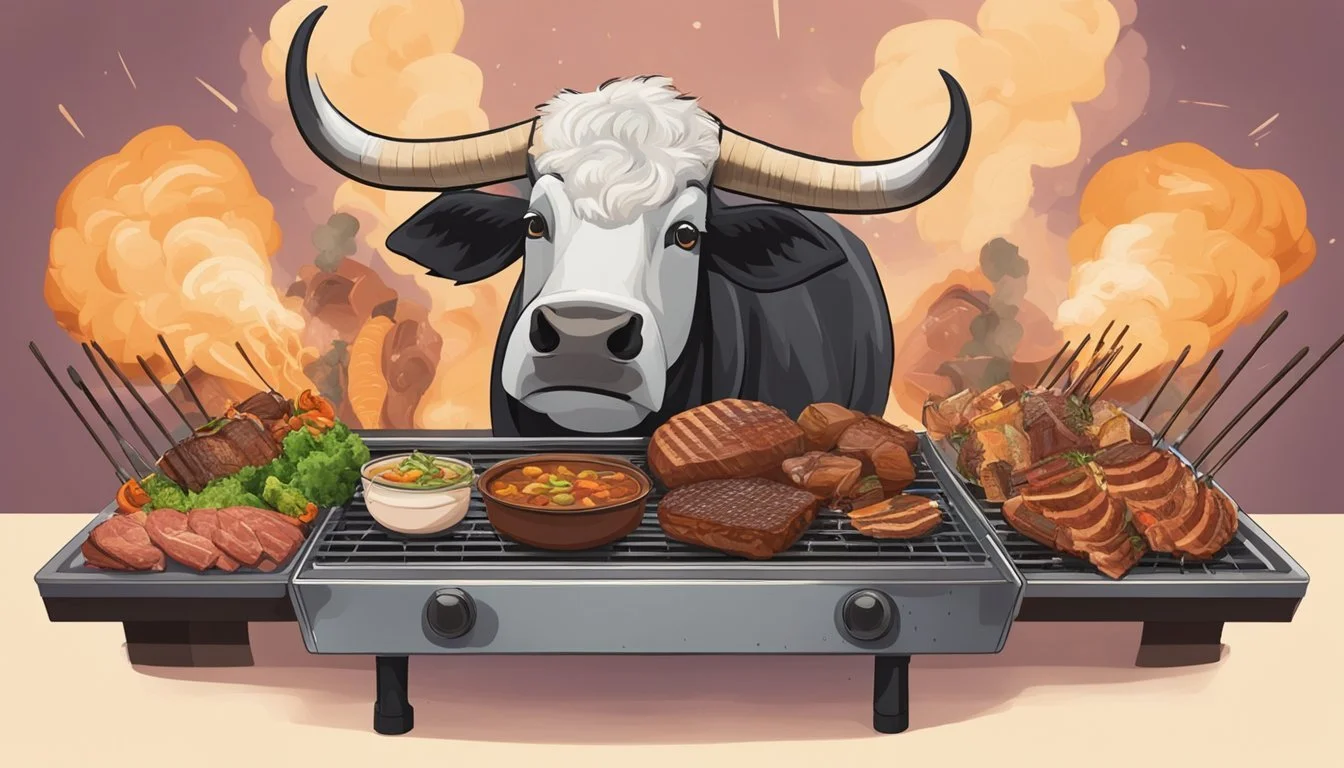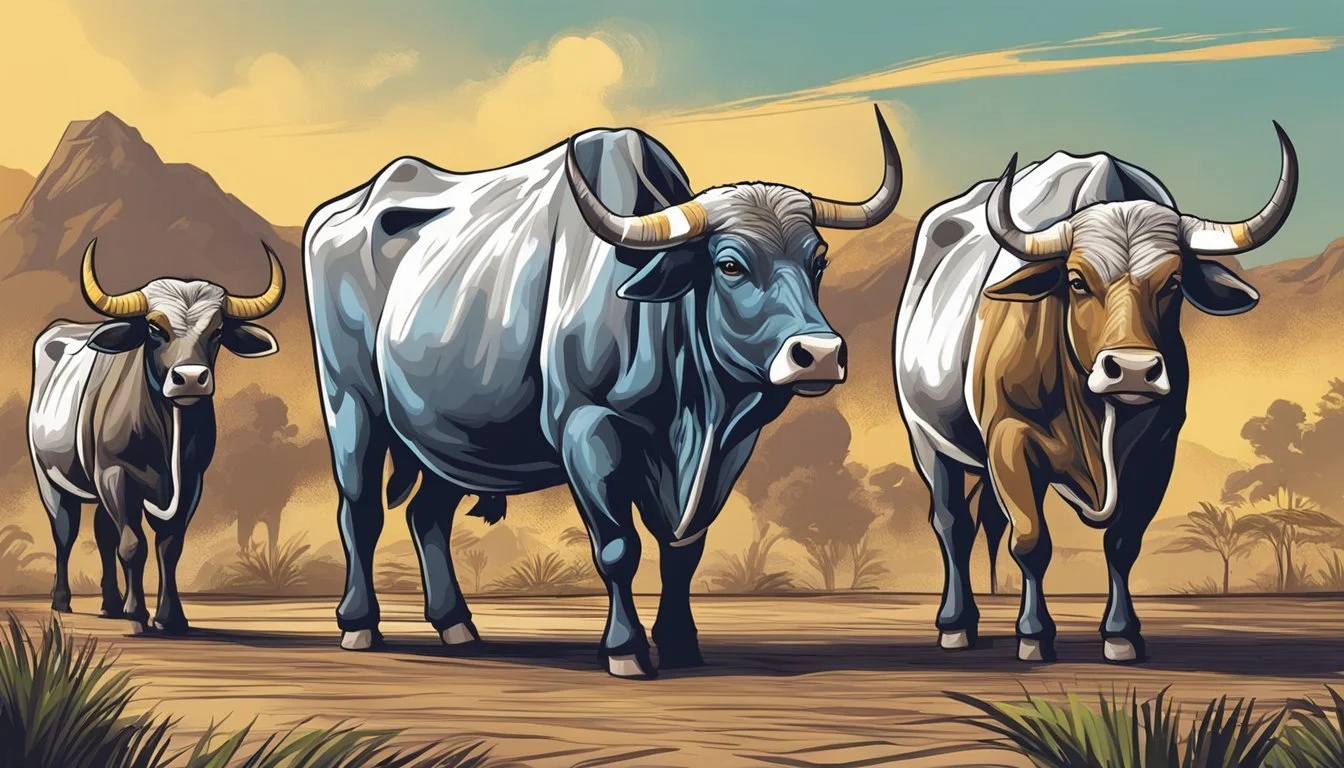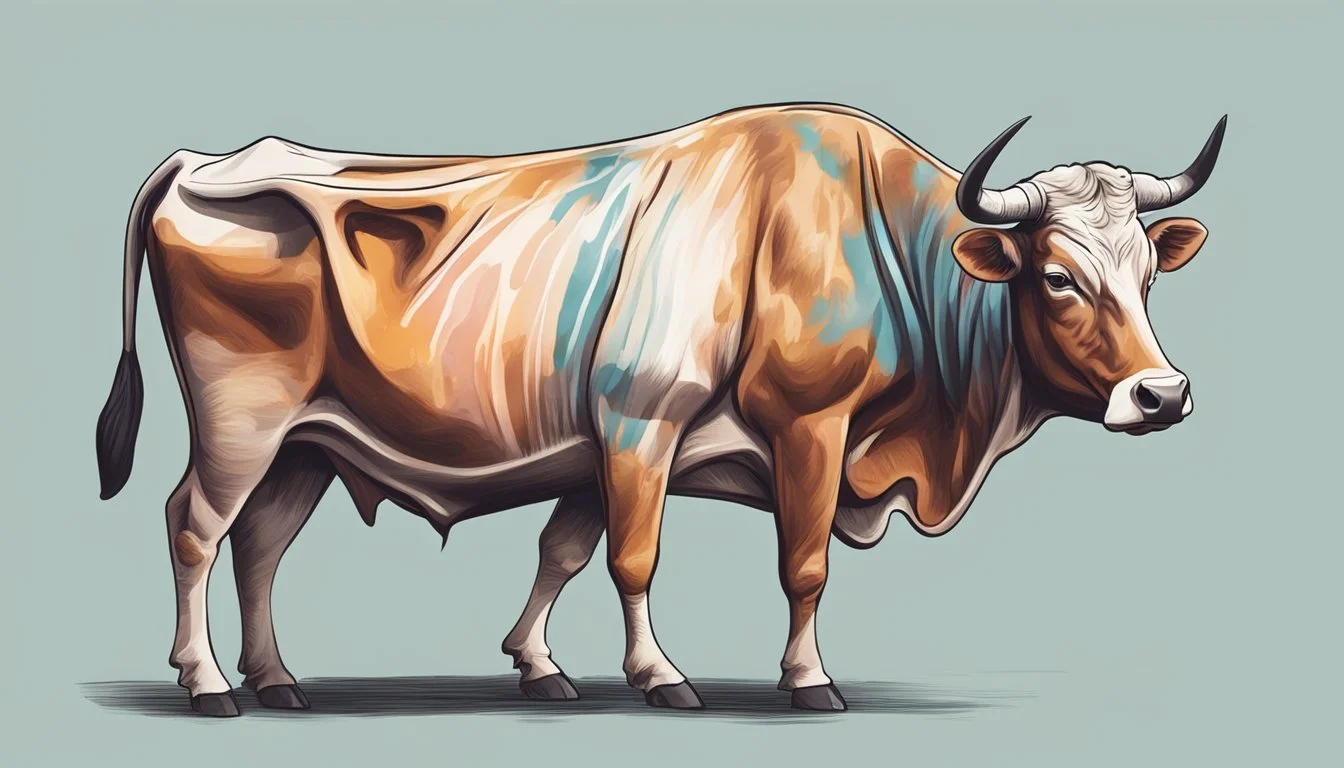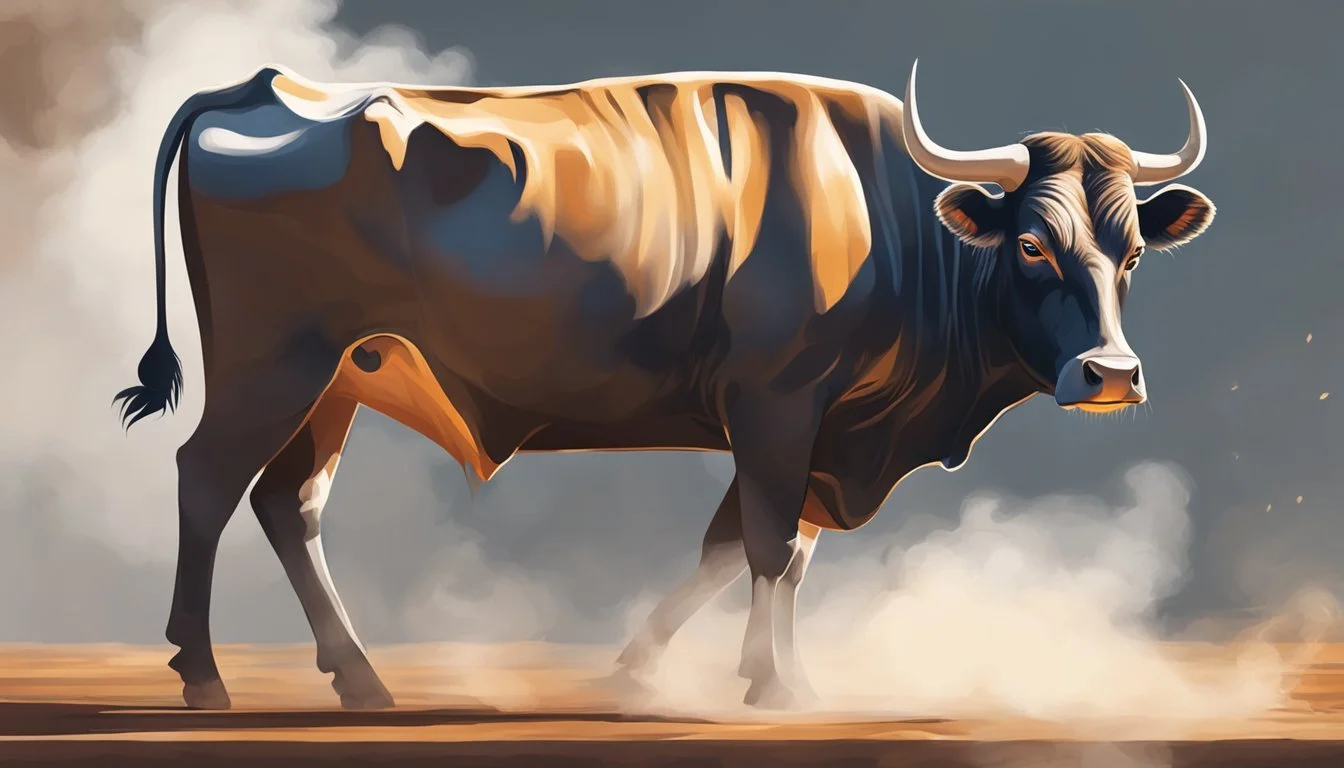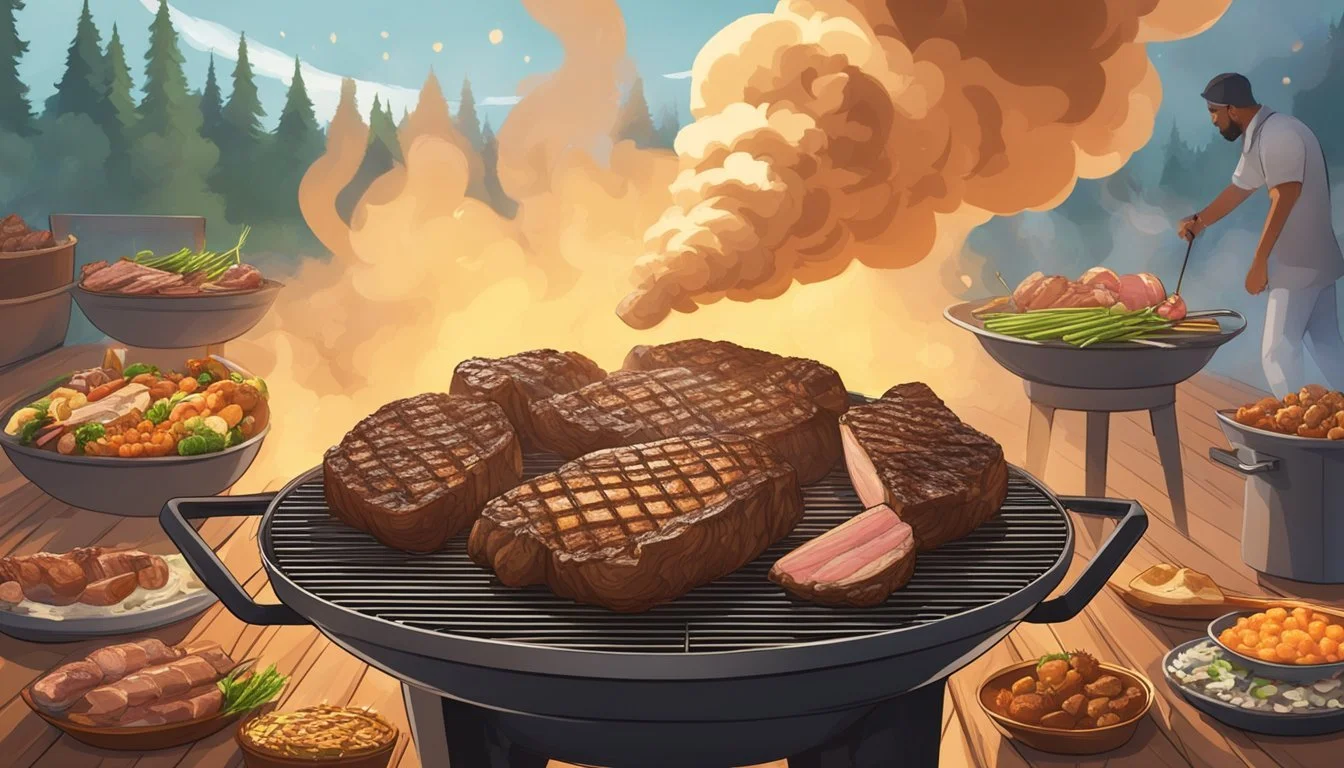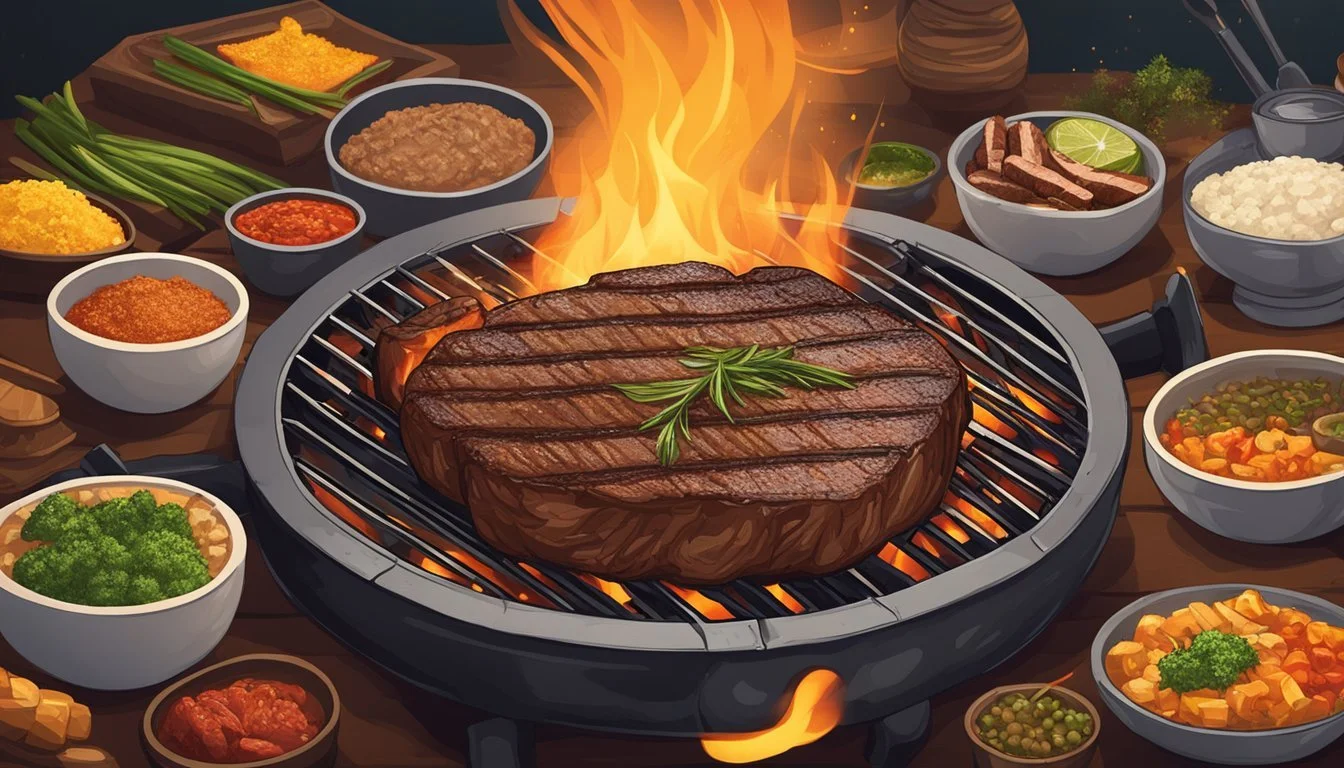Zebu Hump
Exploring Brazil's Churrasco Delicacy for Carnivores
The traditional Brazilian churrasco encompasses a variety of succulent meat cuts, each contributing its distinctive flavor and texture to the grill. Among these, the Zebu hump, known as 'Cupim' in Portuguese, holds a special place on the Brazilian barbecue roster. This particular cut is harvested from the hump of Brazilian Zebu cattle, a breed renowned for its resilience and distinctive physical characteristics, particularly the muscle-rich hump on its back—a feature not commonly found in cattle breeds outside of Brazil.
Cupim, with its rich marbling and tender consistency, is a meat lover's delight, offering a taste experience found almost exclusively in Brazilian cuisine. Brazilian chefs traditionally prepare Cupim by stewing or roasting, techniques that render the meat's fibrous texture into an exceptionally flavorful and succulent dish. This beef cut, celebrated for its fattiness and stringy, tender meat, is a staple in churrascarias, where it is often considered a gourmet delicacy.
In Brazil, the culinary techniques employed to cook Cupim maximize the cut's natural advantages. It is often cooked slowly, allowing its fat to melt and its fibers to soften, resulting in a juicy and satisfying dish that perfectly captures the essence of Brazilian churrasco tradition. Whether enjoying the vibrant atmosphere of a churrascaria or a home barbecue, the Zebu hump stands out as a distinctive and sought-after staple, embodying the rich flavors and cultural heritage of Brazil's storied culinary landscape.
The Essence of Brazilian Churrasco
Brazilian churrasco is not merely a method of preparing meat but a culinary tradition steeped in history, with the Brazilian steakhouse or "churrascaria" providing an authentic experience that embodies the country's rich meat-cooking culture.
Origins and Cultural Significance
Churrasco began with the gauchos, or cowboys of southern Brazil, who played a critical role in the evolution of this barbecue style. These rugged cattle herders adopted a simplistic approach to cooking, often involving open flames and large skewers upon which various cuts of meat were grilled to perfection. This method of cooking, deeply rooted in Brazilian culture, reflects the country's appreciation for quality meat and communal dining. Soon, these techniques were influenced and further refined with the arrival of Portuguese explorers, who introduced new livestock, enriching the variety available for churrasco.
Churrascaria Experience
Upon entering a churrascaria, guests can expect an endless parade of meats, an essential feature of a typical Brazilian steakhouse. Servers move from table to table offering a variety of grilled meats, (What wine goes well with grilled meats?) slicing them directly onto diners' plates. This includes the popular and generous Zebu hump, a distinctive and flavorful cut from the Zebu cattle. What makes Brazilian churrasco stand out is not just the food but the entire authentic atmosphere; the ambiance of the restaurant is designed to evoke the gauchos' tradition, with an array of sides and salads complementing the meats, and the open grill visible, bringing diners closer to the heart of Brazilian culinary art.
Key Cuts and Meats
In Brazilian churrasco, an array of select cuts and meats play starring roles, each contributing its unique texture and flavor to the culinary tapestry. Predominantly beef-centric, churrasco also welcomes a variety of meats, catering to an expansive palate.
Picanha: The Star of the Show
Picanha, deemed the crown jewel of Brazilian barbeques, commands attention with its striking balance of lean meat and rich fat cap. Cut from the top of the rump, this cut is known for its intense beefy flavor and succulent tenderness when cooked. Grilled expertly as a whole before being sliced, picanha's hallmark is a medium-rare center shielded by a glistening char.
Beyond Beef: Diverse Offerings
Brazilian churrasco isn't limited to beef; it's a meat lover's symphony. The menu includes:
Top Sirloin (Alcatra) — preferred for its robust flavor and hearty texture.
Beef Ribs — slow-cooked for supreme tenderness.
Pork — diverse cuts such as ribs and tenderloin grace the grill.
Lamb steals the scene in two forms:
Lamb Chop — prized for its delicate taste and tenderness.
Lamb Steak — offers a fuller flavor and satisfying chew.
Poultry and seafood have their own spotlights with:
Chicken — often marinated and grilled to juicy perfection.
Sausages — a staple in churrasco, ranging from mild to spicy.
Bacon-Wrapped Chicken — a harmonious blend of flavors.
Seafood — including shellfish and salmon, expands the churrasco tradition beyond land fare.
The Art of Grilling
The Brazilian churrasco centers on the mastery of grilling techniques and the harmonious blending of seasonings to enhance the naturally marbled textures of the meat, such as the distinctive Zebu hump. The pursuit of the perfect sear brings out the tender qualities of the beef, while preventing it from becoming tough or dry.
Techniques and Seasonings
Grilling is both a science and an art form in Brazilian churrasco. It starts with the cut of meat, particularly the cupim or Zebu hump, known for its rich marbling. The meat is traditionally skewered on large metal swords or rods and grilled over open flames. This method infuses the meat with a desirable char that complements its innate flavors.
A common seasoning approach involves a liberal coating of coarse salt before grilling. The salt not only seasons the beef but also plays a role in forming the coveted crust on the meat's surface. The key is allowing the meat to reach room temperature for even seasoning penetration and employing a two-zone fire for precise temperature control to avoid overcooking.
Coarse Salt: Enhances flavor, aids crust formation
Rosemary (optional): Adds aroma, remove before grilling
Achieving the Perfect Sear
The perfect sear is paramount in Brazilian churrasco; it locks in the juices of the Zebu hump, ensuring each bite is succulent. To achieve this, the meat should be placed on the grill approximately 17 inches from the embers. They are typically seared for six minutes on each side for a medium rare finish. This method transforms the rich fatty layers of the Zebu hump into a tender texture, while preventing it from becoming too tough or drying out.
After grilling, the meat must rest for a few minutes. This resting period allows the juices to redistribute throughout the cut, maintaining its moisture and tenderness upon serving.
Placement: Center cut 17 inches from embers
Timing: Grill 6 minutes per side for medium rare
Rest: Allow to rest for juices to redistribute and retain tenderness
All-You-Can-Eat: A Gastronomic Journey
This section of the article indulges in the all-you-can-eat experience at a Brazilian churrascaria, detailing the abundant variety from the salad bar to the succulent selection of meats.
Salad Bar and Accompaniments
A Brazilian churrascaria experience typically begins with a visit to a salad bar laden with an assortment of fresh and healthy options. Diners encounter an array of vibrant vegetables, exotic fruits, and a selection of traditional Brazilian appetizers. Notable among these starters are pao de queijo—small, warm cheese breads with a delightful chewy texture—and farofa, a seasoned manioc flour mixture, often sprinkled over rice for a satisfying crunch. The salad bar serves as the perfect starting point to balance the forthcoming meats with lighter fare, including hearty sides like creamy mashed potatoes.
The Endless Parade of Meats
The heart of the churrascaria experience reveals itself through the endless parade of meats, where the famed Cupim, or Zebu hump, stars as a highlight. Servers, known as 'passadores,' weave through the restaurant offering a ceaseless supply of perfectly grilled meat straight from the skewer. Diners enjoy the rich, fatty, and wonderfully marbled cuts of the Zebu cattle, which is a breed distinguished by its prominent hump. The meat's tender and slightly stringy texture is a meat lover's dream, and it is just one of the many premium cuts offered in the all-you-can-eat buffet. Each serving is an indulgence in the culinary tradition of Brazilian churrasco, an experience that is as authentic as it is unforgettable.
Brazilian Drinks and Desserts
In the panorama of Brazilian gastronomy, the drinks and desserts stand out for their rich flavors and cultural significance. These offerings complement the country's meat-centric churrascos with a balance of sweetness and zest.
Signature Cocktails and Beverages
Brazilian cocktail culture is epitomized by the Caipirinha, the national drink made with cachaça (sugarcane hard liquor), sugar, and lime. It offers a refreshing, tangy taste that pairs remarkably well with the rich flavors of Brazilian meats.
Ingredients for a Caipirinha:
Cachaça: 2 oz
Lime: Half, cut into wedges
Sugar: 2 teaspoons
Muddle the lime and sugar in a glass, add cachaça and ice, and stir thoroughly. This cocktail serves as the perfect entry to a joyful social gathering or a palate cleanser between flavorful bites.
In addition to the Caipirinha, Brazil is home to a variety of fruit-based juices and soft drinks, with guaraná-flavored beverages being particularly prominent. Derived from the seeds of the guaraná plant, these drinks are rich in caffeine and serve as a stimulating complement to any meal.
Sweets to Conclude
The sweetness in Brazilian desserts often comes from an array of traditional recipes that have been passed down through generations. Not just an afterthought, these desserts are as integral to Brazilian cuisine as the main courses themselves.
A popular Brazilian dessert is Sonho, translating to 'dream' in English. Resembling a cream-filled doughnut, Sonho has a crispy exterior, offset by a soft, airy middle, often accompanied by a delicate dusting of sugar on top.
Another beloved treat is Cajuzinho, which translates to 'little cashew.' It’s a bite-sized sweet often shaped into a miniature cashew fruit and coated in granulated sugar, embodying the flavors of its namesake nut, which is native to Brazil.
While these treats are different from the savory selection of meats offered at a churrasco, they provide a sweet conclusion, striking a delightful contrast that leaves a lasting impression on the palate.
Special Diets and Preferences
When it comes to Brazilian churrasco, the focus is often on the abundance of meat. However, special diets and preferences, such as vegetarianism, are gaining more attention. Brazilian steakhouses and churrasco gatherings are adapting to offer options for vegetarians and those looking for traditional meat alternatives.
Options for Vegetarians
While the classic Brazilian churrasco experience revolves around meats like the Zebu hump, vegetarians can find solace in the assorted side dishes and newly introduced vegetarian skewers. Many Brazilian steakhouses now offer:
Grilled vegetables: A colorful array of skewered and seasoned vegetables grilled to perfection.
Salad bars: Often extensive, featuring a diverse range of fresh and marinated vegetables, beans, and cheeses.
Roots and tubers: Cassava, yams, and sweet potatoes provide a hearty substitute with a Brazilian twist.
Traditional Alternatives
For guests who abstain from red meat but are willing to try other animal proteins, several traditional non-beef options are typically available at a churrasco:
Chicken hearts: A delicacy in Brazil, these are savory and tender, usually seasoned and grilled on skewers.
Leg of lamb: Another popular choice, it's marinated and slow-cooked over the open flames, offering a rich and slightly gamey flavor.
Seafood: Although not as common, options like shrimp and fish can sometimes be found at churrascarias, grilled with a blend of Brazilian spices.
Brazilian churrasco can cater to a variety of dietary preferences with planning and willingness to explore the rich culinary landscape beyond beef.
Unique Brazilian Flavors
Brazilian cuisine offers an exciting array of flavors, particularly reverberated through its meat dishes. The complexity and richness found in the cuts and accompaniments create a dance of taste that's integral to the cultural fabric of Brazil.
Feijoada and Other Classics
Feijoada stands as Brazil's beloved national dish, a hearty stew brimming with black beans and a mix of pork and beef cuts. Filet mignon and rump cover (the latter commonly referred to as picanha) often feature in this culinary mosaic. Picanha, also known as rump cap, is a premium cut and a churrasco staple, celebrated for its top-layer fat that imparts a unique flavor when grilled.
Other classics include:
Farofa: Cassava flour toasted with butter, salt, and bacon, often served alongside churrasco.
Polenta: A cornmeal staple that provides a creamy counterpart to the savory meats.
Sauces and Marinades
The essence of Brazilian barbecue, or churrasco, is not just in the meat itself but also in the marinades and sauces. The meats might be marinated in a mixture featuring cachaça—a Brazilian spirit distilled from sugarcane juice—which tenderizes the meat and adds a distinctive flavor.
Popular sauce options include:
Chimichurri Sauce: An uncooked sauce used both in cooking and as a table condiment, chimichurri typically contains parsley, garlic, vinegar, olive oil, and flakes of chili pepper.
Marinades and sauces are used sparingly to complement the meats' natural flavors rather than overpower them. The combination of these unique elements contributes to the rich tapestry of flavors that define Brazilian culinary tradition.
Maximizing the Churrasco Experience
To ensure an authentic and fulfilling churrasco experience, one should pay close attention to traditional methods and restaurant selection. Engaging with the cultural practices and knowing what to look for in a churrascaria can significantly enhance the enjoyment of Brazilian barbecue.
Tips from the Gauchos
Gauchos, the South American cowboys, are the pioneers of churrasco. They recommend using only the highest quality meats for grilling. The Cupim, or the zebu hump, is a unique and sought-after Brazilian cut known for its marbling and flavor. Costela, the beef ribs, should be cooked slowly to achieve a tender texture, and cuts like picanha (rump cap) and fraldinha (bottom sirloin) are prized for their rich taste.
For seasoning, simplicity is key; salt often suffices to bring out the natural flavors of the meat. However, additional offerings such as linguica (a Portuguese sausage) and chorizo enhance the meat platter with spicy and robust flavors. Meats should be cooked over wood fire for authenticity and periodically basted with a mix of melted fat and coarse salt to retain moisture and create a crispy outer crust.
Key Meats to Include:
Cupim (Zebu Hump)
Costela (Beef Ribs)
Picanha (Rump Cap)
Fraldinha (Bottom Sirloin)
Linguica (Portuguese Sausage)
Chorizo
Cooking Method:
Slow and over a wood fire
Baste with fat and salt
Choosing the Right Restaurant
Selecting a Brazilian steakhouse or churrascaria that prioritizes the churrasco tradition and offers a range of high-quality cuts is crucial for the ultimate churrasco adventure. One should look for eateries that feature rotisserie-style grilling and where the chefs are skilled at maintaining the fine balance of flavor and tenderness in every slice served.
The ambiance plays a significant role as well: the right churrascaria will immerse diners in the festive atmosphere characteristic of Brazilian gatherings. Observing the inclusion of traditional carbohydrates like Pão de Queijo (cheese bread) or farofa (toasted cassava flour mixture) can also indicate authenticity. The experience is often complemented by a salad bar to balance the meat-centric meal.
Restaurant Features to Look For:
Rotisserie-style grilling
Variety of high-quality meat cuts
Traditional side offerings (Pão de Queijo, farofa)
Festive atmosphere
In sum, maximizing the churrasco experience involves learning from the gauchos, choosing meats wisely, and selecting a churrascaria that adheres to tradition while providing a festive and genuine atmosphere.

